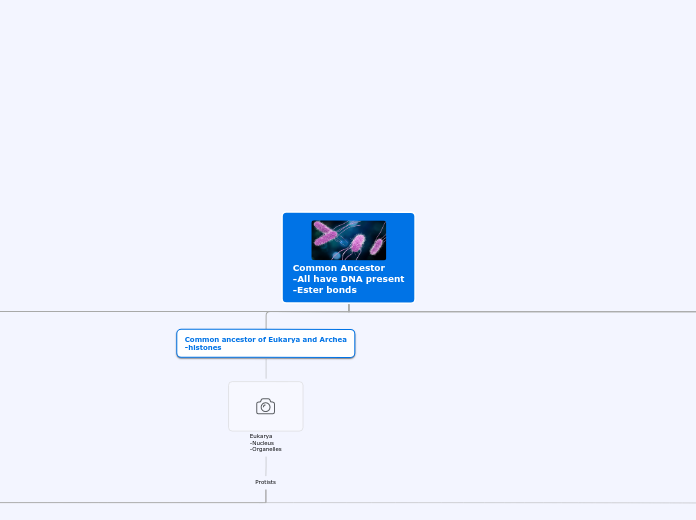por Farid Asmar 4 anos atrás
600
Organigram

por Farid Asmar 4 anos atrás
600

Mais informações
UNIKOTA CLADE (animals and fungi)
Opisthokonts -Single posterior flagellum on swimming cells -Absorvatibe Heterotrophy
Fungi -multicellularity -chitin cell wall -zygotic cycle with dikaryotic stage
Animals -multicellularity -mobility -complex organ systems -gametic life cycle
Eumetazoa -tissues
Cnidaria -diplobasly -radial symmetry
33
Scychophoza -majority of life as medusa stage
Hydrozoa -alternating polyp and meduza forms
Anthozoa -usually only polyp
Bilatera -triplobasty -bilateral symmetry
Protosomia -spiral and determinate cleavage -blastopre becomes mouth
Ecdysozoa -ecdysis -metamorphosis
Nematoda -roundworms -free-living and parasitic -cuticle -pesudocoelom -complete digestive tract
Anthropoda -"jointed foot" -segmented -exoskeleton -complete digestive tract -open circulatory system
Chelicerates -cephalothorax and abdomen -4 parts of walking legs, pedipalps, chelicerae
Pancrustaceans
Hexapoda -six legs -insects -many have wings -head, thorax, abdomen
Crustaceans -cephalothorax
Lophotrochozoa -lophophore and/or troco larvae
Plathyelminthes -acoelomates -incomplete digestive tract -no respiratory or circulatory systems
Cestoda -lack a mouth and gastro -vascular cavity
Tremaptoda -parasitic -no digestive tract
Rhaditophorans -free living -parasitic
Annelida -cephalization -segmented worms -closed circulatory systems -complete digestive tract
Mollusca -soft-bodied -foot, visceral mass, mantle -coelomates -organ systems
Bivalia -shells in two halves -suspension feedings
Gastropoda
Cephalopoda -tentacles to grasp prey -closed circulatory system
Deuterostomia -radial and indeterminate cleavage
Echinodermata (Giant sea star) -Water vasuclar system -spiny skin -no brain -complete digestive track
Asteroidea
Holothuroidea
Echnioderie -no arms -jawlike structure
Chordata -Notochord -Dorsal nerve cord -Pharyngeal Slits -Endostyle
Common ancestor of vertebrates and urochordates
Cephalochordata
Urochordata
Vertebrates -4 chordate characteristics -vertebral column -endoskeleton -cranium -complex organ system -4 limbs -single circulation
Heart with 2 chambers -jaws, mineralized skeleton
common ancestor with lung derivatives
common ancestor
tetrapods with 2x circulation
Amniotes -limbs with digits
Mammalia -4 chambered heart -amniotic egg -hair -milk
Reptilia -3 or 4 chambered heart -ectothermic -endothermic -amniotic egg
amphibia -lungs -3 chambered hearts -ectothermic
Lobed finned fishes -jawed -bony skeleton -lungs -ectothermic
Osteichthyans (Ray finned fishes) -gnathostomes -actinopterygii -lungs -ectothermic "
Chonodrichthyes -jaws -cartilage skeleton -ectothermic -tendency to sink -predators
Agnathans -jawless -2 chamber heart -ectothermic -cartilage skeleton
Porifera
Choanoflagellates
Amoebazoa -Pseudopodia that extend like tubes
ARCHAPLASTIDA -Primary Plastid
Green Algea
charophytes -zygotic -gametophyte -Diffusion and osmis
chlorophytes/bryophytes -sporic -uses embryos -dessication resistant -apical meristems -presence of gametangia -presence of sporangia -Diffusion and osmis -gametophyte -no stomata
Common Ancestor
Spermatophytes -Pollen -Seeds -Heterospory -Wood -Ovules
Angiosperms -Presence of fruit -Presence of flowers -Endosperm -Ovaries
Subtopic
Gymnosperms
Seedless Vascular -lignin -xylem/phloem -dominant sporophyte generations -waxy cuticle -stomata
Monilophytes
Lycophytes
Hornworts
Mosses
Liveworts
EXCAVATA -Has feeding groove -Secondary plastid
SAR CLADE
Rhizaria -Filose pseudopodia
Stramenopila -Tripartite flagellar hair -Secondary plastid
Alveolata -Membranous Vesicles on the cell membrane -second or tertiary plastids